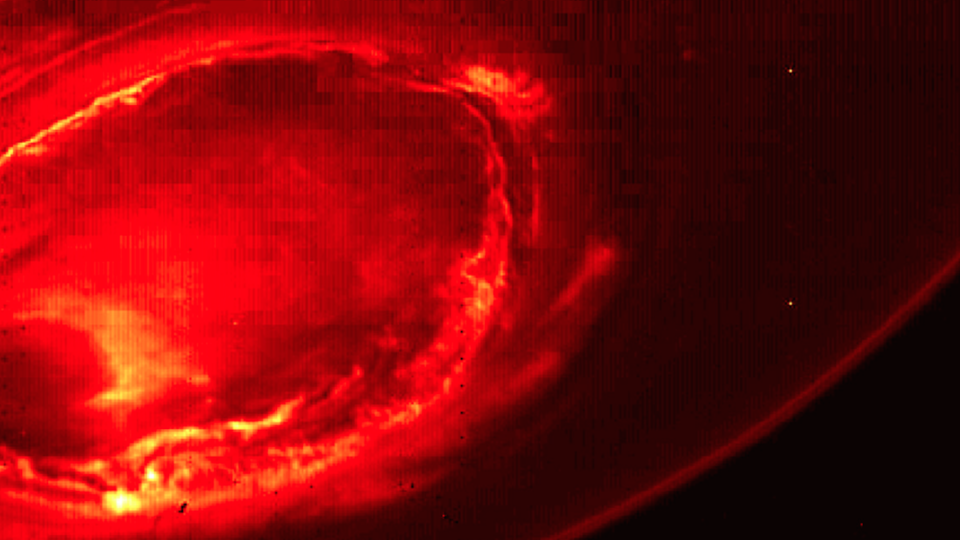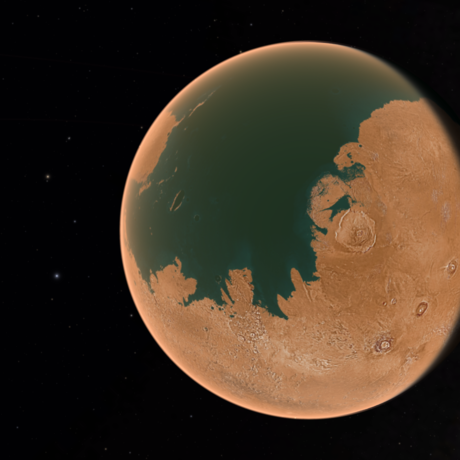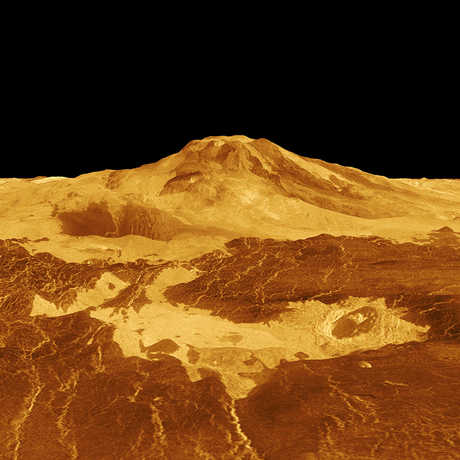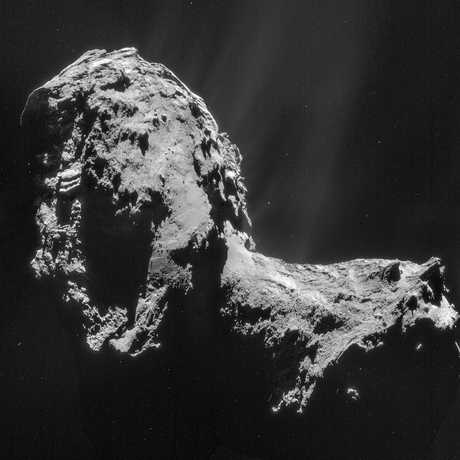Science News
Osiris-Rex, Philae, Juno, Cassini at Titan, and a Slow Pulsar

OSIRIS-REx: On Its Way
After a perfect launch Thursday evening from Cape Canaveral, OSIRIS-REx began its seven-year journey to the asteroid Bennu and back, with its Sample Return Capsule expected to land in the Utah desert on September 24, 2023.
That’s a long trip!
The spacecraft—whose name stands for Origins, Spectral Interpretation, Resource Identification, Security, Regolith Explorer—is heading to Bennu for many reasons, as its name implies. The asteroid holds clues to our past—astronomers estimate Bennu is 4.5 billion years old, and it’s thought to harbor primordial material left over from the formation of the Solar System. Similar asteroids could be the source of water and organic molecules that may have made their way to Earth billions of years ago. OSIRIS-REx will spend about a year mapping the asteroid and its surface and the payoff will be a “high-five,” where a robotic arm will extend from the spacecraft and collect between two and 70 ounces (about 60 to 2,000 grams) of surface material (the Regolith part of the craft’s name) to return to our planet.
In addition, the asteroid will be examined for mining potential (that’s the Resource Identification part) and Security. As a near-Earth asteroid, Bennu will cross Earth’s orbit in about 160 years and there’s a tiny chance it could impact our planet. “By visiting Bennu we can very precisely determine its orbit, determine the physical forces affecting it, and do a much better job of predicting where it will be in the next couple of hundred years,” says University of Colorado’s Daniel Scheeres. “By then we should know if we need to start building a giant space tugboat.” –Molly Michelson
Phinding Philae
In an image taken by the European Space Agency’s Rosetta spacecraft on September 2, the wayward Philae lander has finally been spotted on the surface of Comet 67P/Churyumov-Gerasimenko. Launched in 2004, Rosetta took 10 years to loop through the Solar System, using a series of flybys of Earth and Mars to accelerate it fast enough to reach its target. After a 10-year journey, Rosetta rendezvoused with the rubber duck-shaped comet in November 2014 and deployed washing machine-sized Philae for an unpowered landing on the smaller of the two lobes comprising the comet (otherwise thought of as the top of the duck's head). However, the spindly-legged craft was unable to anchor itself to the ground on contact and instead took a long, slow bounce in the comet's weak gravity. With no way to control its flight, it took a ballistic trajectory across the one-kilometer (0.6 mile) crater dubbed Hatmehit, clipping the edge of the crater and going into a spin before finally tumbling onto its side in the shadow of a high feature that was named “Perihelion Cliff.”
With only about 60 hours of power in its batteries, Philae required prompt attention. Controllers scrambled to operate as many instruments aboard the lander and gather as much information about its surroundings as it could, which was relayed to Earth by the orbiting Rosetta. Then, with its batteries exhausted and its solar panels unable to collect sunlight, Philae went silent. Although Philae made fleeting, intermittent contact, it never lasted long enough to pinpoint the lander’s location. Despite numerous attempts, controllers finally gave up and declared Philae lost in March 2016, and with no expectation of ever making contact again, they shut the communication system off in July.
Based on Philae’s approach and images taken by Rosetta from orbit, mission controllers had a rough idea of where they thought the rebound took it, but were never sure until sharp-eyed image analyst Cecilia Tubiana found it in a high-resolution image taken from a distance of only 2.7 kilometers (1.7 miles). As shown in earlier images from Philae itself, the lander lay on its side, helplessly lodged in a rocky crevice.
Philae’s recovery brings a sense of closure to its mission, which despite not having gone quite as planned, nonetheless qualifies as a success. It accomplished the first landing on a comet, it survived the landing, and it collected valuable information about the comet. On top of that, Rosetta continued orbiting the comet, collecting additional data and taking spectacular high-resolution images.
Now, with less than a month before the mission ends, the comet is getting too far from the Sun for Rosetta’s solar panels to provide enough power to operate. Controllers are planning to guide the craft to a slow approach and (they hope) a gentle touchdown on September 30. Its approach will occur even more slowly than Philae’s, at half the velocity, or about 50 centimeters (20 inches) per second, so Rosetta doesn’t bounce off the comet like the lander. While locations are still under discussion, it’s been suggested that a landing near Philae’s now-known final resting place would be sentimentally appropriate, reuniting the two hardy space-travellers at the end of their 12-year mission. (Come on, ESA, make it happen!) –Bing Quock
Northern Storms and the Southern Aurora
After the first of 36 orbital flybys of Jupiter on August 27, the Juno spacecraft captured never-before-seen views of the gas giant’s north and south poles, revealing severe storms and a huge aurora.
During its orbit, the spacecraft came about 4,200 kilometers (2,500 miles) above Jupiter’s swirling clouds. The download of six megabytes of data collected during the six-hour transit, from above Jupiter’s north pole to below its south pole, took one-and-a-half days. While analysis of this first data collection is ongoing, some unique discoveries have already made themselves visible.
“First glimpse of Jupiter’s north pole, and it looks like nothing we have seen or imagined before,” says Scott Bolton, principal investigator of the Juno mission. “It’s bluer in color up there than other parts of the planet, and there are a lot of storms. There is no sign of the latitudinal bands or zone and belts that we are used to—this image is hardly recognizable as Jupiter. We’re seeing signs that the clouds have shadows, possibly indicating that the clouds are at a higher altitude than other features.”
But it’s perhaps the infrared image of Jupiter’s south pole that’s most stunning. “While we knew that the first ever infrared views of Jupiter’s south pole could reveal the planet’s southern aurora, we were amazed to see it for the first time,” explains Alberto Adriani from Istituto di Astrofisica e Planetologia Spaziali. “No other instruments, both from Earth or space, have been able to see the southern aurora. Now, with JIRAM [the Jovian Infrared Auroral Mapper onboard Juno], we see that it appears to be very bright and well structured. The high level of detail in the images will tell us more about the aurora’s morphology and dynamics.”
“The largest planet in our solar system is truly unique,” concludes Bolton. “We have 35 more flybys to study just how unique it really is.” –Molly Michelson
The Dunes of Shangri-la and the Mysteries of Xanadu
In 2004, NASA’s Cassini spacecraft arrived at the ringed planet Saturn, entering an orbit from which it made multiple observations of the planet’s atmosphere, rings, and moons. On July 25, Cassini made its 122nd flyby of Saturn’s largest moon, Titan, passing about 1,000 kilometers (600 miles) from it—about a third of its diameter. Using radar to peer through Titan’s dense, hazy atmosphere, the orbiter has mapped the giant moon’s surface topography, and during its July approach, it focused on a dark area along the equator known as Shangri-la. Such dark regions on Titan are thought to be lowland plains, which may once have harbored seas of liquid methane. High-resolution radar scans of Shangri-la revealed long, linear dunes, possibly consisting of hydrocarbon particles that settle out of the atmosphere. Like sand dunes on Earth, the dunes on Titan may help scientists understand the winds that form them, the size of the particles they’re made of, and the structure of the landscape beneath them. In fact, such dune-filled areas appear to encircle most of Titan’s equator.
Another area, adjacent to Shangri-la and nicknamed Xanadu annex by mission scientists, was also observed. This appears to be similar to the larger, more obvious, Australia-sized Xanadu feature to the north that was previously spotted by the Hubble Space Telescope in 1994. However, what has scientists puzzled is that Xanadu annex was missed by Hubble while Cassini was able to pick it out and show that it appears to consist of the same type of terrain. According to radar team member Mike Janssen, “There seems to be something different about the surface there that masks this similarity when observing at other wavelengths, as with Hubble.” Some think that Xanadu may be a large expanse of Titan’s oldest surface—perhaps a vestige of icy crust that is periodically rinsed of organic sediments by methane rains, as suggested by the numerous channels and valleys that run through it.
Why methane?
Nearly a billion miles from the Sun, Saturn and its moons don’t receive much warmth from our star, and Titan’s surface temperature was measured by the Huygens probe, which parachuted to the surface from Cassini. Huygens found conditions on Titan rather chilly—around –180°C (–290°F). At that temperature, liquid water can’t exist, but liquid hydrocarbons, such as methane and ethane, can, and these have been detected on the surface. Just as Earth has a water cycle circulating through its air, land, and seas, there is a similar methane cycle occurring on Titan. This also has scientists wondering about the possibility of methane-based chemistry on Titan that might allow liquid methane to act as a solvent for life-supporting reactions in the same way that water does on Earth.
The Cassini mission will end in late 2017 with the “Grand Finale,” a series of risky, looping orbits that pass between the planet’s cloud tops and its innermost rings, ending—if all goes as planned—with a plunge into the planet’s atmosphere on September 15.
The Cassini mission will be the subject of a talk at the Academy on October 24 by Carolyn Porco, head of the Cassini imaging team, as part of the Benjamin Dean Lecture Series. –Bing Quock
The Pokiest Pulsar
Stars much more massive than our sun undergo dramatic, violent changes as they age, often climaxing in catastrophic explosions called supernovae. These rip the outer envelopes of the stars to gaseous tatters called supernova remnants, leaving superdense cores behind that pack the mass of stars several times that of the Sun down to objects about 10 kilometers (six miles) across—about the size of a city. It’s calculated that a sugar-cube-sized lump of material from this shrunken stellar core, called a neutron star, may weigh about 100 million tons.
Heavy, man.
A neutron star has a powerful magnetic field which channels the star’s energy out in tight beams, and as the star rotates, the beam sweeps around like a lighthouse beacon. If Earth is in the path of a rotating beam, we pick up a pulse of energy. This is how the first-known pulsating star, or pulsar, was discovered in 1967 by Jocelyn Bell.
As they collapse catastrophically, neutron stars increase their rate of rotation, in the same way that a spinning ice skater spins faster with his or her arms pulled in, and because they shrink to such a tiny fraction of their original size, neutron stars spin very fast—a famous example is the pulsar within the Crab Nebula in Taurus, spinning about 30 times per second. On the other hand, pulsars that form in binary star systems may draw material from their companion stars, which imparts more angular momentum to them and cause them to speed up even more, creating an entirely different class of objects, called millisecond pulsars, that can spin hundreds of times per second.
That said, x-ray astronomers have announced that they have found evidence for the slowest pulsar yet detected. Using a combination of orbiting and ground-based facilities, they detected a highly-magnetized neutron star (also called a magnetar) at the heart of a supernova remnant 9,000 light years away. Named 1E 161348-5055 (or 1E 1613 for short), it appears to rotate once every 6.67 hours. Previously, the slowest-spinning magnetars were known to spin once every 10 seconds. The extremely slow rotation of 1E 1613 is a complete mystery, and astronomers are proposing different mechanisms to explain it, the leading theory involving the infall of material from the supernova remnant, causing the neutron star’s rate of spin to slow down.
Since the Universe rarely produces only one of anything, the search is on for other slow-spinning magnetars. –Bing Quock


